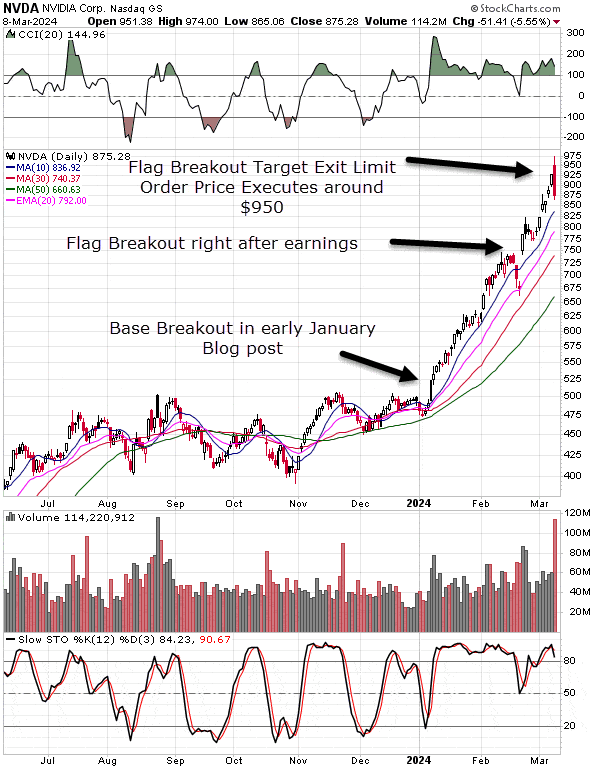A Simple Yet Effective Swing Trading Exit Strategy
With so many indicators, technical measures, and ways to analyze a stock, its easy to lose sight of one of the simplest, most effective exit strategies.
This is the sell limit order. And its a type of order that every swing trader, especially those who work full time, should be familiar with.
What is a Sell Limit Order?
A sell limit order is just an order type where you give a “limit price” which is the least amount you are willing to sell the stock for.
So, in the last blog post on trading NVDA, we talked about how we traded the earnings flag breakout on NVDA. The target sell price on the trade was around $935 in the daily alert service after getting in around $750 or so.
So after buying the stock, you would place a limit order for at least a part of your position to sell at $935. Any of the major online brokers will have the option to enter a sell limit order. You typically just click this option after clicking a sell button and scroll down to the limit option and then enter the limit price.
Once you place the order, you are telling the broker to sell the stock automatically and immediately once it reaches $935 or above as long as someone pays you at least $935.
In some cases, such as with NVDA, the price will gap over this limit price. By gapping we mean the first trade of the day is made above the prior close. In this case, NVDA gapped over the $935 sell limit order price.
So, in the case of NVDA, the sell price you would have received would have been around $950 because the first trade of the day was above $935 and around $950.
Here is the chart of the entry and target on NVDA from the last blog post.

Charts courtesy of StockCharts.com
AVAV, PANW and BELFB and also good examples of stocks that would have sold for a nice profit in the daily alert service using a limit order before a sharp pullback. There will be plenty of other great stocks that will form bullish base patterns and reach a good technical entry point with a fresh catalyst.
The Advantages of Using a Sell Limit Order
Over more than 15 years of trading, we have seen many cases where a stock reaches our price target and then starts to pull back soon after.
We generally do not trade penny stocks but great growth stocks like NVDA and SMCI. So the stocks we trade tend to pull back when the rally ends instead of crash as with penny stocks.
This makes trading with a full time job or life outside the market difficult in the case of trading penny stocks. This is why we focus on better quality small, mid cap and even large cap growth stocks in this case.
Its easy to “feel greedy” once a stock is rallying hard through your swing trading target price. Emotionally, you will find yourself less willing to sell some shares if all is going well. However, a good technical target is where you want to take at least a portion of your profits.
Forget to take your profit and your profit can turn into a loss. By placing a limit order right away for a portion of your profits, the limit order automatically sells at the target whether you are at work or at home.
Using a limit order can prevent even good traders from snatching defeat from the jaws of victory 🙂
The other benefit of using a sell limit order is the time savings. Once you place the order, that’s it. Either it hits the limit price or not.
In fact, you can use an OCO (one cancels the other) order with a lot of online brokers where you can put in a stop-loss and a sell limit order for your profit target at the same time. So you can have your protective stop and limit order working for you even while you are at work.
The cost of an OCO order? Its usually free nowadays. Pretty cost effective.
When We Do Not Use a Limit Order
A limit order is nearly always great to use for a portion of your profits.
However, the stocks with the best growth metrics, in a long-term uptrend, relative strength near highs, and fast start are the ones where it makes sense to keep more for a longer-term move. Commissions are free nowadays with a lot of online brokers so this is a very viable option where you take partial profits initially and let the remainder run while tightening your stop.
But the majority of great trading opportunities do not get off to a terrific start like NVDA and SMCI. Most also do not have mid double digit to triple digit growth in sales and earnings either. But those are the ones where you want to keep more longer.
Over the years we have talked about looking for a test of the 20 EMA and then a rebound into new highs again for a place to exit a swing trade. So, taking the rest off if the stock closes below the 20 EMA and goes below that days low.
If it instead rebounds off the 20 on a first test, taking more off with a trailing stop below the prior days low or 2 day low. Ideally, selling into strength when another move above the prior swing high loses some steam after the test of the 20. This would have worked great with SMCI.
Then we wait for another bullish technical pattern to set up just so. SMCI broke out of multiple high, tight flags after the initial ascending base breakout. Our high tight flag entry/exit strategy worked like a charm for those using the high tight flag course.
In Summary
Limit orders can save you a lot of time, lost profits and frustration when trading. Its rare to be able to “top tick” a rally on a stock. We just want to be sure to get a good chunk of the move after an amazing catalyst that is much better than expected and then wait for the next consolidation pattern to develop if there is another one.
You can take some profits while letting the remainder run and putting those profits to work on the next great trade. In fact, taking partial profits is good risk management because you cannot lose on that portion of your position if you have already taken a profit on it.
Of course, we use other good trend following exit strategies as well. There are certain sell signals we always pay attention to.
If you work full time or want to spend time on other things during the day, a limit order is like your personally assistant. It automatically does the job of taking profits so you can get those profits into cash or into your next trade. An OCO order will also stop losses short which is key to success long-term trading.
Usually, a well thought out limit order will get you out of most trades as the gains per day are fading or about to fall. We have found at that point you can often do better per day in another ideal swing trade that is just reaching a good technical entry point.
This is the whole point of swing trading versus buy and hold. Eventually a stock will pull back after a strong run. It could consolidate for many years, in fact, and never again reach new highs.
In the next blog post we will be talking about how 50 trades in a year at an average of 5% per trade can easily crush a 500% move in a stock. Its a blog post studying rapid account growth in a bull market using great short-term technical swing trading strategies.
We have extended the special offer to try the 3 Stocks to Wealth strategy on our sister site, investtobefree.com. It had another great week and is on a record breaking pace so far in 2024.
How to Ride the 3 Top Stocks for the Weeks Ahead with Less Risk
Other Exit Signals and Trader Confidence




